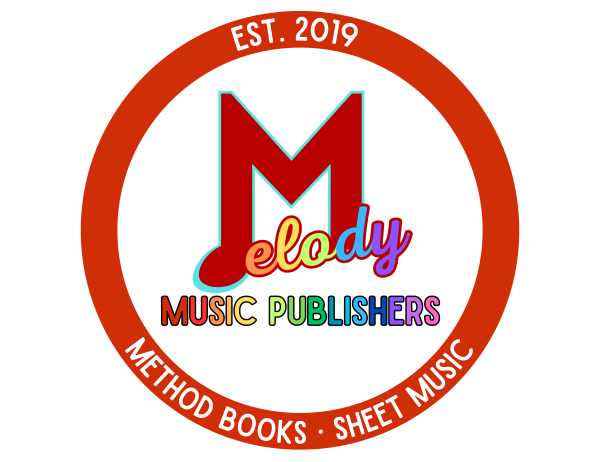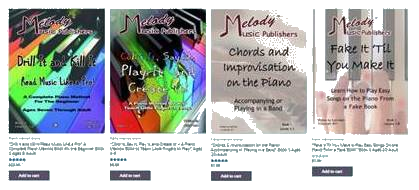What Piano Teachers Think About Method Books
What do piano teachers think of the current method books on the market? I’ve played piano my whole life and actually started teaching as a child to my friends that begged me to teach them. After college, I began teaching professionally in. In 1989 I founded Melody Music Studios, hiring music instructors for all instruments. I realized shortly after teaching that the method books didn’t help students read music fluently and caused a lot of frustration. So I started writing my own workbooks to supplement the method books, “Rhythm Workbook” and “Note Reading Workbook”. Even with the workbooks supplementing, I was still frustrated because most method books are basically a book of songs with little to no instruction, or a clear step by step direction.
I’m so excited about my books that I want to share with ALL piano teachers. Teachers can fill out a short form to receive free PDF samples and discount codes for 20% off when ordering. My favorite field on the form is the question: “What method books do you use, and why do you like or don’t like them?”. Here are some of the interesting answers I’ve received.
Quotes From Piano Teachers Nationwide!
“I use various method books = Piano discoveries for bright readers, Faber and Faber for the middle of the road student and Music Tree. I think Faber uses too many finger numbers and Piano Discoveries is a bit hard for the average learner. I love the Music tree philosophy, but fine their books a bit dry and academic.”
“I like Alfred Premier and Faber. I think the music is engaging and the concepts are introduced in a clear way. I’m not a fan of Hal Leonard or Bastien. I feel they are not the best way to introduce music concepts.”
“I am eclectic, founding something useful from everything since I also teach students learning difficulties and disabilities.”
” Faber, it has a lot of jazz, pop tunes. I love the progression.”
“Faber Piano Adventures. I am content to use them, but after so many years, a change of approach may be helpful.”
“Faber and Alfred–I like the multi-key approach, fun pieces, and the emphasis on correct technique.”
“Alfred, Faber – getting stale”
“Faber Piano Adventures (mostly) Logical order, enjoyable content”
“The ones that I have used with my students, I like them. “Color, Say it, Play it”, and Drill It and Kill it. It helped my students learn how to read notes with ease and made it more fun. Drill it also helped with their sense of rhythm.”
“Faber, Bastien, and Music for Little Mozarts. I like the way Faber introduces the notes on the staff and how the hands aren’t always in the same position. On the flip side, I like Bastien for some students because it does stay in one or two positions in the beginning. Sometimes I will start students in Bastien and then switch them to Faber.”
“Faber (technique, pacing); Celebrate Piano! (reading approach, theory/ear training, creative pieces)”
“Succeeding at the Piano, The Music Tree, Piano Safari, Piano Pronto”
“Alfred Premiere Piano Course. Upbeat pieces, concepts in stepwise, logical order, good explainer boxes.”
“I use a variety of methods from Piano Pronto to Piano Adventures to none depending on the needs of the student.”
“Faber Piano Adventure, I like this method but open to learn new approach. Thank you!”
“I like what I use but am always looking to improve.”
“I use Piano Safari and Music Tree. I like that they offer intervallic reading, and with Piano Safari, also do Rote teaching so students can experience more complicated pieces before being able to read them.”
“Bastien piano books- I like how they correspond with each other so that the child can feel like he/she is receiving more than one book around the same level that each teach a different technique and strength”
“I use Faber for children and generally both Faber/Alfred for adults. I think the method books move a little too quickly for a lot of adults which is why I use 2 separate ones.”
“The only one I use with all levels/all ages is Mikrokosmos volume 1 by Bela Bartok. For suppliment.”
Main theme about current method books
The main comments I’ve received seem to be that most piano teachers use an assortment of method books. I understand that, since each student is unique and different students may require different books . However, it seems like teachers use an assortment of books mostly because one book doesn’t have all the aspects of teaching they want. One book may have great songs, while another uses more theory, while another has an easier step by step learning.
Inspiration For a New Line of Piano Books
One day as I was teaching, I got inspired to write my own method book that would include everything a student needed, all in one book. So 2017 I started writing “Drill It and Kill It-Read Music Like a Pro!” This 200 page book includes the note reading and rhythm drills from the workbooks, but also exercises, special exercises for specific skills, scales, theory, composition, and 100 great original songs that include what is learned in each chapter. It’s not just a book of songs, but a text book, theory, and a history book. Finally one book for the traditional lesson that teaches everything, and lasts for a year or more. t’s so easy to use in a lesson because of the comprehensiveness and easy to follow step by step learning. I also love watching my own students learn how to sight read any song!
Learning Chords & Improvisation
For an older child or adult that just wants to learn chords and improvisation, the “Chords & Improvisation on the Piano” is the perfect book. Along with teaching scales, key signatures, triads, and inversions, it also includes assignments for the student to play what is learned with improvisational patterns. Then there’s the older student that wants to play their favorite easy song without a lot of hassle in learning to read a full score. My “Fake It Til You Make It” book includes just the treble clef notes and chords for the left hand, so the student can play fun songs from a fake book. If you have a student that just needs a little extra help in reading notes or rhythm, the “Note Reading Workbook” and “Rhythm Workbook” gives drills and writing assignments to have the student reading professionally. No Every Good Boy Does Fine is taught in the note reading workbook.
For the Young Students
There are a lot of books written for the preschool age, but this 50 page book for ages 4-8 called “Color It, Say It, Play It, and Create it” starts out as a coloring book for the 7 keys using the 7 colors of the rainbow, and includes drills, fun children’s songs, assignments for rhythm, and composition. It stresses rhythm, counting, and how to keep a steady beat, which a lot of books do not offer for this age. There is also drills for the student to listen and copy for ear training. The staff notes are not introduced, but the notes ascend and descend as though it’s on a staff, making it easy for the student to learn to read notes after completing it.
I would love to share my books with you! To order, simply go to the store and use your discount codes for 20% off! This is not a temporary discount, but a permanent discount for you to use each time you order books for you or your students. I appreciate your dedication and giving a gift for a lifetime to each of your students! Please feel free to comment below, so others can read and learn from your experiences. Thank you.
Kathi Kerr/owner and author of Melody Music Studios and Melody Music Publishers
.
What Piano Teachers Think About Method Books Read More »

